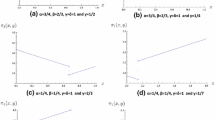Abstract
In this paper, we propose a compartmental model where the electorate is divided into six classes or sub-populations: potential electors (P), unregistered individuals (U), registered individuals (R), temporary abstainers (\(\hbox {A}^t\)), voters for the political party (\(\hbox {V}^f\)) and voters against the political party (\(\hbox {V}^a\)). Our model describes the electoral behavior of citizens with regards to the electoral process in general and with regards to a political party in particular. It includes three controls representing strategies that can help to increase the participation rate at elections and boost a political party’s chances of getting more votes. We formulate an optimal control problem based on the proposed model. Pontryagin’s maximum principle is used to characterize the optimal controls and the optimality system is solved by an iterative method. The numerical results carried out using real data with the Moroccan legislative elections of 2016 show the performance of our optimization strategies.







Similar content being viewed by others
References
Abrams, S., Iversen, T., Soskice, D.: Informal social networks and rational voting. Br. J. Polit. Sci. 41(2), 229–257 (2011)
Antunes, R.: Theoretical models of voting behaviour, sciences de la communication et des affaires, exedra No 4 (2010)
Bartle, J., Birch, S., Skirmuntt, M.: The local roots of the participation gap: inequality and voter turnout. Elect. Stud. 48, 30–44 (2017)
Bartolini, S., Mair, P.: Identity, Competition and Electoral Availability. Cambridge University Press, New York (1990)
Belenky, A.S., King, D.C.: A mathematical model for estimating the potential margin of state undecided voters for a candidate in a US Federal election. Math. Comput. Model. 45, 585–593 (2007)
Berelson, B.R., Lazarsfeld, P.F., Mcphee, W.N.: Voting: A Study of Opinion Formation in a Presidential Campaign. Chicago University Press, Chicago (1954)
Blais, A.: To Vote or Not to Vote: The Merits And Limits of Rational Choice Theory. University of Pittsburg, Pittsburg (2000)
Boyce, W.E., DiPrima, R.C.: Elementary Differential Equations and Boundary Value Problems. Wiley, New York (2009)
Calderon, K., Orbe, C., Panjwani, A., Romero, D.M., Kribs-Zaleta, C., Ros-Soto, K.: An epidemiological approach to the spread of political third parties. mtbi.asu.edu/Sum (2005)
Downs, A.: An Economic Theory of Democracy. Harper Collins Publishers, New York (1957)
Fleming, W.H., Rishel, R.W.: Deterministic and Stochastic Optimal Control. Springer, New York (1975)
Guibout, V., Bloch, A. M.: A discrete maximum principle for solving optimal control problems. In: 43rd IEEE Conference on Decision and Control, vol. 2, pp. 1806–1811 (2004)
Gumel, A.B., Patidar, K.C., Spiteri, R.J. (eds.): Asymptotically Consistent Non-standard Finite-Difference Methods for Solving Mathematical Models Arising in Population Biology. R. E. Mickens and Worl Scientific, Singapore (2005)
Gumel, A.B., Shivakumar, P.N., Sahai, B.M.: A mathematical model for the dynamics of HIV-1 during the typical course of infection. Nonlinear Anal. Theory Methods Appl. 47(3), 1773–1783 (2001)
Hodler, R., Luechinger, S., Stutzer, A.: The effects of voting costs on the democratic process and public finances. Am. Econ. J. Econ. Policy 7(1), 141-71 (2015)
Hoffman, M., Léon, G., Lombardi, M.: Compulsory voting, turnout, and government spending: evidence from Austria. J. Public Econ. 145, 103–115 (2017)
Karrakchou, J., Rachik, M., Gourari, S.: Optimal control and Infectiology: application to an HIV/AIDS model. Appl. Math. Comput. 177(2), 807–818 (2006)
Khan, Q.J.A.: Hopf bifurcation in multiparty political systems with time delay in switching. Appl. Math. Lett. 13, 43–52 (2000)
Laarabi, H., Labriji, E., Mostafa, M.R.: Optimal control of an epidemic model with a saturated incidence rate. Nonlinear Anal. Model. Control 17(4), 448–459 (2012)
Lazarsfeld, P.F., Berelson, B., Gaudet, h: The People’s Choice: How The Voter Makes Up His Mind in a Presidential Campaign. Columbia University Press, New York (1944)
Leighley, J.E., Nagler, J.: Who Votes Now? Demographics, Issues, Inequality, and Turnout in the United States. Princeton University Press, Princeton (2013)
Miller, W.E., Shanks, J.M.: The New American Voter. Harvard University Press, Cambridge (1996)
Nickerson, D.: Is voting contagious? Evidence from two field experiments. Am. Polit. Sci. Rev. 102(1), 49–57 (2008). https://doi.org/10.1017/S0003055408080039
Petersen, I.: Stability of equilibria in multi-party political system. Math. Soc. Sci. 21, 81–93 (1991)
Pontryagin, L.S., Boltyanskii, V.G., Gamkrelidze, R.V., Mishchenko, E.F.: The Mathematical Theory of Optimal Processes. Wiley, New York (1962)
Schelker, M., Schneiter, M.: The elasticity of voter turnout: Investing 85 cents per voter to increase voter turnout by 4 percent? Elect. Stud. 49, 65–74 (2017)
Author information
Authors and Affiliations
Corresponding author
Additional information
Publisher's Note
Springer Nature remains neutral with regard to jurisdictional claims in published maps and institutional affiliations.
Rights and permissions
About this article
Cite this article
Balatif, O., El Hia, M. & Rachik, M. Optimal Control Problem for an Electoral Behavior Model. Differ Equ Dyn Syst 31, 233–250 (2023). https://doi.org/10.1007/s12591-020-00533-9
Published:
Issue Date:
DOI: https://doi.org/10.1007/s12591-020-00533-9




